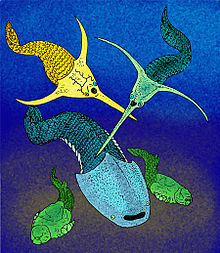Galeaspid
| Galeaspida Temporal range: 430–400 Ma Mid Silurian to Early Devonian |
|
|---|---|
 |
|
| Scientific classification | |
| Kingdom: | Animalia |
| Phylum: | Chordata |
| Subphylum: | Vertebrata |
| Class: |
†Galeaspida Liu, 1965 |
| Orders | |
|
Eugaleaspidiformes Liu, 1965 |
|
Eugaleaspidiformes Liu, 1965
Huananaspidiformes Janvier, 1975
Polybranchiaspidiformes Janvier, 1996
Galeaspida (from Latin, "Helmet shields") is an extinct taxon of jawless marine and freshwater fish. The name is derived from galea, the Latin word for helmet, and refers to their massive bone shield on the head. Galeaspida lived in shallow, fresh water and marine environments during the Silurian and Devonian times (430 to 370 million years ago) in what is now Southern China, Tibet and Vietnam. Superficially, their morphology appears more similar to that of Heterostraci than Osteostraci, there being currently no evidence that the galeaspids had paired fins. However, Galeaspida are in fact regarded as being more closely related to Osteostraci, based on the closer similarity of the morphology of the braincase.
The defining characteristic of all galeaspids was a large opening on the dorsal surface of the head shield, which was connected to the pharynx and gill chamber, and a scalloped pattern of the sensory-lines.
The opening appears to have served both the olfaction and the intake of the respiratory water similar to the nasopharyngeal duct of hagfishes. Galeaspids are also the vertebrates which have the largest number of gills, as some species of the order Polybranchiaspidida (literally "many gills shields") had up to 45 gill openings. The body is covered with minute scales arranged in oblique rows and there is no other fin besides the caudal fin. The mouth and gill openings are situated on the ventral side of the head, which is flat or flattened and suggests that they were bottom-dwellers.
...
Wikipedia
